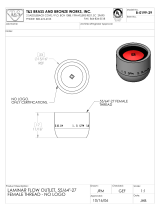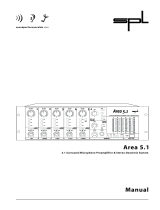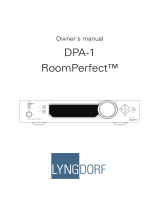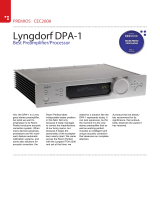Page is loading ...

User’s Manual
DPA 5100 Mobile Surround Microphone

WWW.DPAMICROPHONES.COM
Please visit our website and learn more about DPA Microphones.
© January 2015, DPA Microphones A/S
Product features and specications are subject to change without notice.
DPA 5100 User’s Manual
General description ............................3
5.1 surround sound playback system ..............4
Mounting the microphone .......................4
Connecting and disconnecting the cable ...........5
Cable conguration .............................5
Application notes ..............................5
Outdoor Cover .............................5
Extension units ..............................5
The LFE output ..............................6
Mixing the signals ............................6
Adding time delay to rear channels ...............6
Fold-down to stereo or mono .................6
Down-mix algorithms ........................6
Care of microphone ............................6
Specications & graphs for DPA 5100 .............7
Frequency responses ...........................8
Polar patterns ..................................9
Accessories included ...........................10
Accessories available ...........................10
Service and repair .............................11
Warranty ....................................11
CE marking and environmental policy ............11

General description
The DPA 5100 is an easy-to-use plug and play Mobile Surround Microphone. It has real-time 5.1 discrete analog output channels without any need for further signal
processing. The sound character is very rich and has an enveloping three-dimensional surround atmosphere, yet with appropriate coherence, channel separation and
localization accuracy.
The unit has an enormous dynamic range and low distortion, and is extremely light-weight (530 g/18.7 oz). It is primarily designed for professional use in (HDTV) televi-
sion surround sound production as a “surround ambience adder”, especially in connection with sports events, ambience recor-ding at different venues, documentaries,
talk shows, lm ambience and live music recording.
All microphones in the unit are pressure types as these types exhibit the lowest sensitivity to wind and a consistent low frequency response no matter the distance to
the sound source. In order to reach adequate directional characteristics from a small unit with pressure-only capsules, the new unique DiPMic
TM
technology, designed by
DPA Microphones, has been applied to this design.
DiPMic
TM
stands for Directional Pressure Microphone, and refers to the fact that even though we use pressure microphone capsules that natively result in pure omnidi-
rectionality, directionality is obtained by mounting specially developed interference tubes on the microphones. This combines the best of two worlds: the pressure type’s
advantages in wind, handling and low distortion, and the directionality created by the acoustical grids.
To locate sound direction, the brain picks up crucial information about time, level and spectral differences. The 5100 Mobile Surround Microphone makes use of all these
cue types. Besides using the DiPMic
TM
technology, the appropriate level differences between output channels in the 5100 is obtained using acoustic absorbing bafes
between the microphones, as known from the Jecklin Disc A-B stereo principles.
To create enough spaciousness to the surround eld, some time arrival differences (decorrelation) is also needed. The rear microphones are spaced from each other
and the front array, creating the desired time differences. The front microphones, on the other hand, are time coincident to ensure frequency consistency when down-
mixing to mono.
3

5.1 surround sound playback system
In order for you to benet fully from the intended surrounding effect of the 5100, it is advisable that you are familiar with the 5.1 surround playback setup.
“5” refers to the number of full range discrete channels, “.1” refers to the frequency limited range of the LFE (Low Frequency Effects) channel.
• Two full frequency range channels for speakers at the front: Left (L) and Right (R).
• One full frequency range channel for speaker between left and right: Center (C).
• Two full frequency range channels for surround speakers at the rear: Left Surround (LS) and Right Surround (RS).
• One Low Frequency Effects channel (LFE).
5.1 surround (also known as 3-2 Stereo: three front speakers and two rear speakers) delivers ve discrete audio channels and 1 LFE channel from a six-channel
source. Source media, usually DVD and satellite/digital cable, is often branded with “Dolby Digital” and/or DTS logos. Publically available digital discrete coding
formats are Dolby Digital 5.1, Dolby AC-3, and DTS (Digital Theater System).
Placement: 5.1 speaker layouts should conform to the ITU-R BS.775 standard:
The ITU (International Telecommunication Union) standard states that the left and right speakers
are located at ±30˚, while the rear speakers should be positioned approximately ±110˚ off center axis.
• Three identical front speakers.
• Equal arrival time (radius) between mix position and each speaker.
• If placed behind a silver screen, the screen should be acoustically transparent.
• Surround speakers placed within 100˚ and 120˚.
If more than two surround speakers, symmetrically placed on radius between 60˚ and 150˚.
• LFE runs to separate subwoofer or equally to left/right, and is played back at +10 dB level.
Mounting the microphone
The 5100 has a standard 3/8” microphone stand thread above and below the unit.
Any third part mounting accessory having 3/8” thread can be mounted
– microphone stand, hand grip or the like. Remove the inner thread a
the bottom to acces American 5/8” thread.
4

Connecting and disconnecting the cable
The 5.1 output of the 5100 runs through a multi-pin Lemo connector carrying all six channels electronically balanced. The enclosed DAO5105 5 m (16 ft) six-pair
Mogami cable breaks out to six Neutrik XLR-M connectors. Other cable lengths are available as optional accessories.
Note
To align the two red marks, gently push the connector into the terminal beneath the 5100 until it locks with a click.
Disconnect the cable by drawing it away from the 5100 at the cylinder. This will unlock the connector.
Cable conguration
5.1 channel Cable no. Color code Memory aid
L 1 Yellow L in yeLlow and Left
R 2 Red R in Red and Right
C 3 Orange Combination color between yellow and red
LFE 4 Gray Gray (LFE) does not have full bandwidth
LS 5 Blue Dark colors for Rear Channels:
L in BLue and Left, R in GReen and Right
RS 6 Green
48V Phantom power should be applied to all six cables. Note, the LFE output is only active when phantom power is applied to Left and Right.
Application notes
The DPA 5100 can be used handheld, mounted on a camera, on a microphone stand
or suspended. Further shock absorption is not necessary.
DPA OC5100 Outdoor Cover
When using the 5100 outdoors, always mount the DPA OC5100 Outdoor Cover,
which both protects the unit against rain and reduces wind noise.
Extension units
When mounted on a handheld camera, it may be necessary to
increase the distance between the microphone and any noise
sources such as camera zoom and breathing.
5

The LFE output
The LFE output is derived from a sum of the left and right microphones and is running through a low pass lter at 120 Hz and is attenuated
10 dB conforming with the LFE level standard.
Mixing the signals
The unit is in perfect surround balance and does not need any level off-sets. Simply gain all microphones equally (including the LFE signal).
However, some applications may benet from minor adjustments to achieve the desired level balance on the 5.1 outputs:
• News gathering/interview: Attenuate all channels but center
• Concert hall with large distance to source: Attenuate rear channels
• Acoustical zoom function: Attenuate all channels but center
Adding time delay to rear channels
To increase the sensation of spaciousness it is a recommendable trick to add time delay to the rear channels by typically 10 – 15 ms (corres-ponds to the rear micro-
phones being placed approximately 3 – 5 m (10 – 16 ft) behind the front microphones). This technique works best when the surround directions are consistent, and
may lack front-to-back localization accuracy when recording moving surround environments from the rear.
Fold-down to stereo or mono
The surround signals from the 5100 can easily be folded down for stereo or mono. Since the three front microphones are time coincident, no comb ltering occurs
when summing L, C and R.
Down-mix algorithms
5100 surround outputs
Stereo fold-down Mono fold-down
L R Mono
Left 0 dB - -3 dB
Right - 0 dB -3 dB
Center -3 dB -3 dB 0 dB
LFE +7 dB +7 dB +10 dB
Left Surround -6 dB - -6 dB
Right Surround - -6 dB -6 dB
Care of microphone
DPA 5100 is designed to be very robust and protective materials are used in the construction, including the extremely strong black fabric. Do not try to clean the
microphone as it may be damaged. Avoid all kinds of spray or uids containing chemical components to remove static electricity on or close to the microphone as this
could cause permanent damage to the pre-polarized layer in the capsules.
DPA 5100 is very resistant to water and can easily be used outdoors with the OC5100 mounted, but keep it away from unnecessary exposure to water and cleaning
uids.
Hum issues DPA5100
If low frequency hum issues occur with DPA5100, it is advisable to check for proper ground for the main power supply connection for the microphone preamplier.
Especially on mobile battery operated equipment, when operated with power supply, it is of great importance to ensure ground for the power supply. Due to the high
current consumption of the six channels in DPA 5100, it is more sensitive to ground current ows than other standard mono channel microphones.
6

CRITERIAS
LEFT, CENTER & RIGHT
LEFT SURROUND & RIGHT SURROUND
LFE
UNIT
Directional characteristics
Principle of operation
Cartridge type
Frequency range
Sensitivity, nominal ±3 dB at 1 kHz
Equivalent noise level, A-weighted
S/N ratio (A-weighted), re. 1 kHz at 1 Pa (94 dB SPL)
Total Harmonic Distortion (THD)
Dynamic range
Max. SPL, peak before clipping
Output impedance
Cable drive capability
Output balance principle
Common Mode Rejection Ratio (CMRR)
Power supply
Current consumption
Connector
Color
Dimensions
Weight
[LxWxH]
Capsule diameter
Cable (length/color/diameter/connector)
Maximum output voltage
Polarity
For L/R og LS/RS
Directional
Directional
3 / 2 / 1
DiPMic™ (Pressure, with interference tube)
and separation baffles
Pressure, with separation baffles
Electronically derived
from L + R
Pre-polarized condenser element
Pre-polarized condenser element
20 Hz - 20 kHz
200 Hz-16 kHz (±3 dB)
20 Hz - 20 kHz
100 Hz-12 kHz (±3 dB)
20 Hz - 120 Hz (±3 dB)
26 mV/Pa
28 mV/Pa
Typ. 18 dB(A) (max. 21 dB(A))
Typ. 20 dB(A) (max. 23 dB(A))
Typ. 76 dB(A)
Typ. 74 dB(A)
<1% up to 123 dB
<1% up to 123 dB
103 dB
103 dB
100 dB
132 dB
132 dB
50 Ohm
50 Ohm
50 Ohm
100 m (328 ft)
100 m (328 ft)
100 m (328 ft)
Active signal balanced
60 dB, 50 Hz - 20 kHz
60 dB, 50 Hz - 20 kHz
60 dB, 50 Hz - 20 kHz
Phantom power P48
Typ. 5 mA (max. 5.5 mA)
Typ. 5 mA (max. 5.5 mA)
Typ. 5 mA (max. 5.5 mA)
Lemo multipin
Black
530 g (18.7 oz)
195/240/140 mm (7.7/9.4/5.5 in)
5.4 mm (0.2 in)
5.4 mm (0.2 in)
5 m (16.4 ft)/black/9.3 mm (0.4 in)/XLR
1.8 Vrms/2.5 Vpeak
1.8 Vrms/2.5 Vpeak
1 Vrms/1.4 Vpeak
Positive
Positive
Positive
All 3 microphones are factory selected to the
unit typical within 1 dB.
Both microphones are factory selected to the
unit typical within 1 dB.
Matching front/back
(frequency response and sensitivity)
Specications & Graphs for DPA 5100
7

Frequency responses for DPA 5100
10
-10
0
-20
20 Hz 50 10 0200 5001 kHz2 5102040
10
-10
0
-20
20 Hz 50 10 0200 5001 kHz2 5102040
10
-10
0
-20
20 Hz 50 10 0200 5001 kHz2 5102040
10
-10
0
-20
20 Hz 50 10 0200 5001 kHz2 5102040
10
-10
0
-20
20 Hz 50 10 0200 5001 kHz2 5102040
10
-10
0
-20
20 Hz 50 10 0200 5001 kHz2 5102040
10
-10
0
-20
20 Hz 50 10 0200 5001 kHz2 5102040
Typical frequency response of DPA 5100 at 0 degrees
Typical frequency response of DPA 5100 at 60 degrees
Typical frequency response of DPA 5100 at 120 degrees
Typical frequency response of DPA 5100 at 30 degrees
Typical frequency response of DPA 5100 at 90 degrees
Typical frequency response of DPA 5100 at 150 degrees
Typical frequency response of DPA 5100 at 180 degrees
8

5100 Polær SL
250 Hz
500 Hz
8 kHz
4 kHz
2 kHz
1 kHz
5 dB
5100 Polær Left
250 Hz
500 Hz
8 kHz
16 kHz
4 kHz
2 kHz
1 kH
z
5 dB
5100 Polær Right
250 Hz
500 Hz
8 kHz
16 kHz
4 kHz
2 kHz
1 kHz
5 dB
5100 Polær RS
250 Hz
500 Hz
8 kHz
4 kHz
2 kHz
1 kHz
5 dB
Typical directional charateristics of DPA 5100 (normalized)
Left Surround
5100 Polær Center
250 Hz
500 Hz
8 kHz
4 kHz
2 kHz
1 kHz
5 dB
16 kHz
Center
RightLeft
Right Surround
Polar patterns for DPA 5100
9

Accessories included
DAO5105 Lemo 2B-series 18-pole Female to 6xXLR-M, 5 m (16.4 ft)
OC5100 Outdoor Cover for DPA 5100
DDB2251 Thread adapter 5/8” – 3/8”
Accessories available
DAO5110 Lemo 2B-series 18-pole Female to 6xXLR-M, 10 m (32.8 ft)
DAO5120 Lemo 2B-series 18-pole Female to 6xXLR-M, 20 m (65.6 ft)
DAO5150 Lemo 2B-series 18-pole Female to 6xXLR-M, 50 m (164 ft)
DUA0100 Stand Extension, 100 mm (4 in)
DUA0500 Stand Extension, 500 mm (20 in)
10

Service and repair
Do not service the DPA 5100 yourself. Do not try to open the unit, or it will have to be resealed professionally by the factory. If the fabric is torn, the
unit will suffer from less wind and water protection.
Products from DPA Microphones are extremely stable and there should not be any signicant change in the specications with time and use. If, however,
you are not totally satised with the characteristics exhibited by this product, please contact your nearest DPA Microphones representative for further
details of service and the repair facilities that are available.
Warranty
The DPA 5100 is covered by a standard two-year limited warranty on both mechanical functionality and documented specications as long as the items
are not mistreated, abused or modied in any way. In case of warranty claim your invoice is your warranty registration.
CE marking
The CE mark guarantees that the product conforms with relevant directives approved by the European Commission.
EMC directive: 89/336/EC, amended by 92/31/EC and 93/68/EC
Low voltage directive: 72/23/EC, amended by 93/68/EC
Environmental policy
This product is comprised by the waste (WEEE) directive and should not be thrown in the garbage bin when obsolete. Instead, return it to your local
DPA representative (or DPA Microphones directly) who will dispose of the product in accordance with the current environmental standards.
11

DPI5100
US Sales Oce
DPA Microphones, Inc.
1500 Kansas Avenue, Unit 3A
Longmont, CO 80501
USA
Tel +1 303-485-1025
Fax +1 303-485-6470
Head Oce
DPA Microphones A/S
Gydevang 42-44
DK-3450 Alleroed
Denmark
Tel +45 4814 2828
Fax +45 4814 2700
APAC Sales Oce
DPA Microphones Ltd.
Unit 801-2, 8/F, Asia Orient Tower
33 Lockhart Road, Wanchai
Hong Kong
Tel: +852 2617 9990
Fax: +852 2617 9887
info-apac@dpamicrophones.com
www.dpamicrophones.com
/



